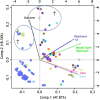Nucleotide substitutions in the mexR, nalC and nalD regulator genes of the MexAB-OprM efflux pump are maintained in Pseudomonas aeruginosa genetic lineages
- PMID: 35536836
- PMCID: PMC9089866
- DOI: 10.1371/journal.pone.0266742
Nucleotide substitutions in the mexR, nalC and nalD regulator genes of the MexAB-OprM efflux pump are maintained in Pseudomonas aeruginosa genetic lineages
Abstract
Pseudomonas aeruginosa has different resistant mechanisms including the constitutive MexAB-OprM efflux pump. Single nucleotide polymorphisms (SNPs) in the mexR, nalC, and nalD repressors of this efflux pump can contribute to antimicrobial resistance; however, it is unknown whether these changes are mainly related to genetic lineages or environmental pressure. This study identifies SNPs in the mexR, nalC, and nalD genes in clinical and environmental isolates of P. aeruginosa (including high-risk clones). Ninety-one P. aeruginosa strains were classified according to their resistance to antibiotics, typified by multilocus sequencing, and mexR, nalC, and nalD genes sequenced for SNPs identification. The mexAB-oprM transcript expression was determined. The 96.7% of the strains were classified as multidrug resistant. Eight strains produced serine carbapenemases, and 11 strains metallo-β-lactamases. Twenty-three new STs and high-risk clones ST111 and ST233 were identified. SNPs in the mexR, nalC, and nalD genes revealed 27 different haplotypes (patterns). Sixty-two mutational changes were identified, 13 non-synonymous. Haplotype 1 was the most frequent (n = 40), and mainly identified in strains ST1725 (33/40), with 57.5% pan drug resistant strains, 36.5% extensive drug resistant and two strains exhibiting serin-carbapenemases. Haplotype 12 (n = 9) was identified in ST233 and phylogenetically related STs, with 100% of the strains exhibiting XDR and 90% producing metallo-β-lactamases. Haplotype 5 was highly associated with XDR and related to dead when compared to ST1725 and ST233 (RRR 23.34; p = 0.009 and RRR 32.01; p = 0.025). A significant relationship between the mexR-nalC-nalD haplotypes and phylogenetically related STs was observed, suggesting mutational changes in these repressors are highly maintained within genetic lineages. In addition, phylogenetically related STs showed similar resistant profiles; however, the resistance was (likely or partly) attributed to the MexAB-OprM efflux pump in 56% of the strains (only 45.05% showed mexA overtranscription), in the remaining strains the resistance could be attributed to carbapenemases or mechanisms including other pumps, since same SNPs in the repressor genes gave rise to different resistance profiles.
Conflict of interest statement
The authors have declared that no competing interests exist.
Figures




References
-
- Maatallah M, Cheriaa J, Backhrouf A, Iversen A, Grundmann H, Do T, et al.. Population structure of Pseudomonas aeruginosa from five Mediterranean countries: evidence for frequent recombination and epidemic occurrence of CC235. PLoS One. 2011;6(10):e25617. doi: 10.1371/journal.pone.0025617 Epub 2011 Oct 3. - DOI - PMC - PubMed
-
- World Health Organization. Global priority list of antibiotic-resistant bacteria. 2021. Available from: https://www.doherty.edu.au/news-events/news/who-global-priority-pathogen....
Publication types
MeSH terms
Substances
LinkOut - more resources
Full Text Sources

